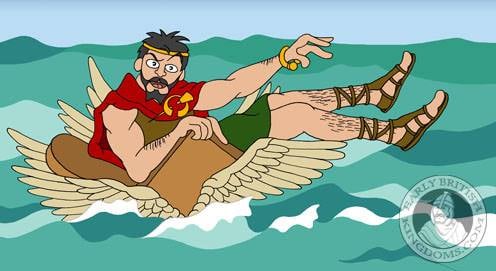 |
 |
|||
|
|
Maelgwn Hir (the Tall) was so associated with the kingdom which he inherited from his father, Cadwallon Lawhir, that he is usually known as Maelgwn Gwynedd. Gildas wrote unfavourably of him in the early 6th century, telling of Maelgwn's murder of his own uncle, probably Owain Danwyn (White-Tooth), in order to secure Gwynedd's crown. Gildas did, however, acknowledge the King's leading position amongst the monarchs of the age and gives him the, not unflattering, title of "Dragon of the Isle": a reference to Ynys Mon (Anglesey). Geoffrey of Monmouth considered him to be a High-King of Britain following Arthur's heir, Constantine, and this is not impossible. Legend tells how, soon after taking the throne, Maelgwn was forced to call together all the petty-kings of North Wales, and probably the rest of Britain, in order to obtain their acceptance of him as their over-king. They met on the sands of what is now called Traeth Maelgwyn, near Ynys Las, and agreed upon a strange competition: as the tide started coming in, all those present sat in chairs along the shoreline; the one who dared to remain seated for the longest would take the High-Kingship. Maelgwn, however, had already made special preparations. His chair had been fitted with waxed bird-wings, so he floated above the waterline and won his prize. Though the Royal capital remained at Aberffraw, Maelgwn mostly liked to hold court at Din-Gonwy (Deganwy) on the Conwy, which became a major centre for the bardic arts. He had another palace at Caer-Gybi on Holy Island that he eventually gave away to St. Cybi to found a monastery. Other saintly men had more troublesome encounters with the king. Maelgwn once heard that St.Padarn, the Bishop of Llanbadarn, had a large store of gold, so devised a plan to trick him out of it. He sent some Royal messengers to the Bishop with sacks of moss and pebbles. Pretending this was the content of the Royal treasury they asked Padarn to retain it in safe keeping while Maelgwn and his armies went off to war. Months later, the messengers returned to collect their sacks but, of course, found them filled with grass and stones. Padarn was immediately dragged before the king and accused of theft. Upon refusing to replace the treasure, the Bishop was forced to undergo a trial by ordeal. Both he and his accusers were obliged to plunge their arms into a pot of boiling water. After a period of healing time, their wounds were examined. The messengers' arms were still raw and painful, but Padarn's burns were completely healed. The saint was thus declared an innocent man, and Maelgwn was forced to admit his deceitful plot. As penance, the King gave Padarn a grant of all the land between the Clorach and the Rheidol. On another occasion, King Maelgwn sent his best white horses to St. Tydecho at Llan-y-Mawddwy, near Dinas Mawddwy for stabling. Instead of setting the animals out to pasture, however, the saint let them run wild in the mountains, eating the heather. When Maelgwn called for his horses' return, he wasshocked to find that they had all turned yellow! He confiscated Tydecho's oxen as punishment, but the saint charmed some woodland stags to pull his plough instead. Later Maelgwn was hunting in the area when he rested on a large rock. He became stuck to the spot, until St. Tydecho arrived to free him. As with many powerful men, Maelgwn was quite the lady's man. The Pictish people, of what is now the Scottish Highlands, even chose him to father the heir to their throne. Their matriarchal society required a man of Royal blood to impregnate their Princess Royal and thus continue the Royal female line. Both Maelgwn's grandmother's were Pictish, and he was therefore considered to be such himself. There is an old story about one of Maelgwn's many partners, that reminds us of his incessant jealousy, though a similar version is also told of King Riderch Hael (the Generous) of Strathclyde's queen. Upon his first marriage, Maelgwn had presented the beautiful Princess Nesta of the Southern Pennines with the traditional gold ring worn by all Queens of Gwynedd. Soon afterwards, however, the new queen lost the ring while bathing in a pool on the River Elwy. Afraid of what her husband would say, she visited the Bishop of Llanelwy (St. Asaphs), St. Asaph, to ask for his help. The saint invited the Royal couple to dinner that evening, where he explained to Maelgwn what had become of the Queen's ring. Maelgwn was furious and immediately accused Nesta of giving the ring away to an impoverished lover. Asaph managed to calm the situation enough for them to sit down to eat, and they all prayed to God that the ring might be found. Fresh fish, caught in the River Elwy, was served first and when the sceptical King cut into his dish, there was the ring inside! Maelgwn abdicated the throne, late in his reign, and entered a monstery but, finding it not to his liking, he returned to the secular way of life, murdered his second queen and his nephew, and married the latter's widow. Soon afterwards, in AD 549, he fled the Royal court to escape the great yellow fever plague that was spreading through the country. He prostrated himself before the altar of the church of Llanrhos and prayed for his life, but it was too late. He died a few days later. It is not widely recognised, but Maelgwn does appear in medieval Arthurian literature where he is represented as Malaguin, the King of the Hundred Knights. Records of King Maelgwn date back to the 6th century. He is considered an historic personage.
|
|||
| © Nash Ford Publishing 2001. All Rights Reserved. | ||||





 Maelgwn Gwynedd, King of
Gwynedd
Maelgwn Gwynedd, King of
Gwynedd